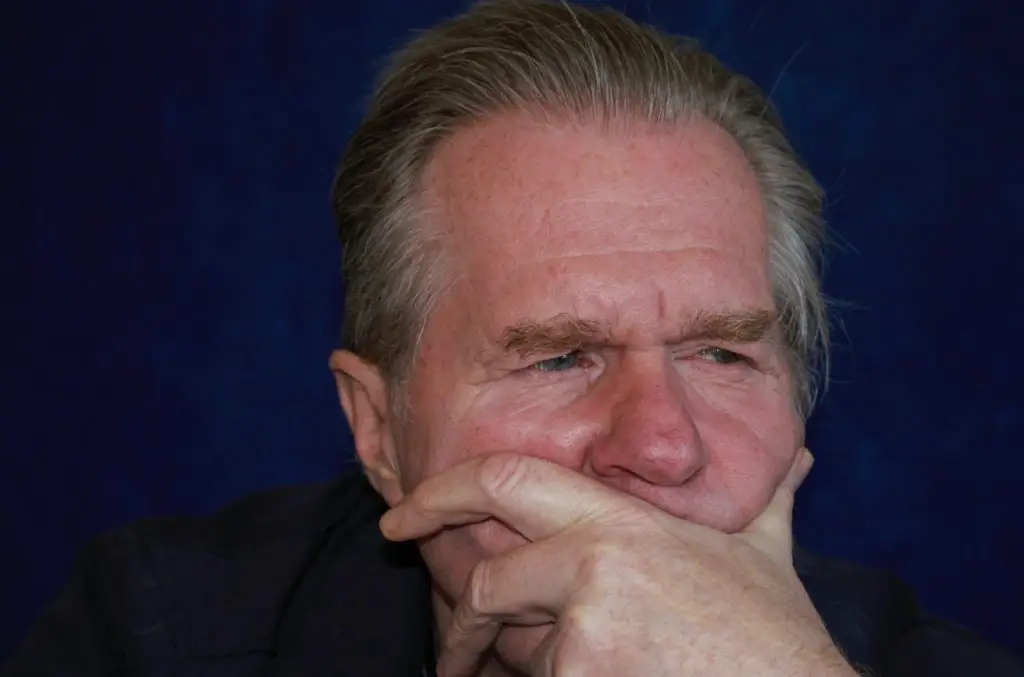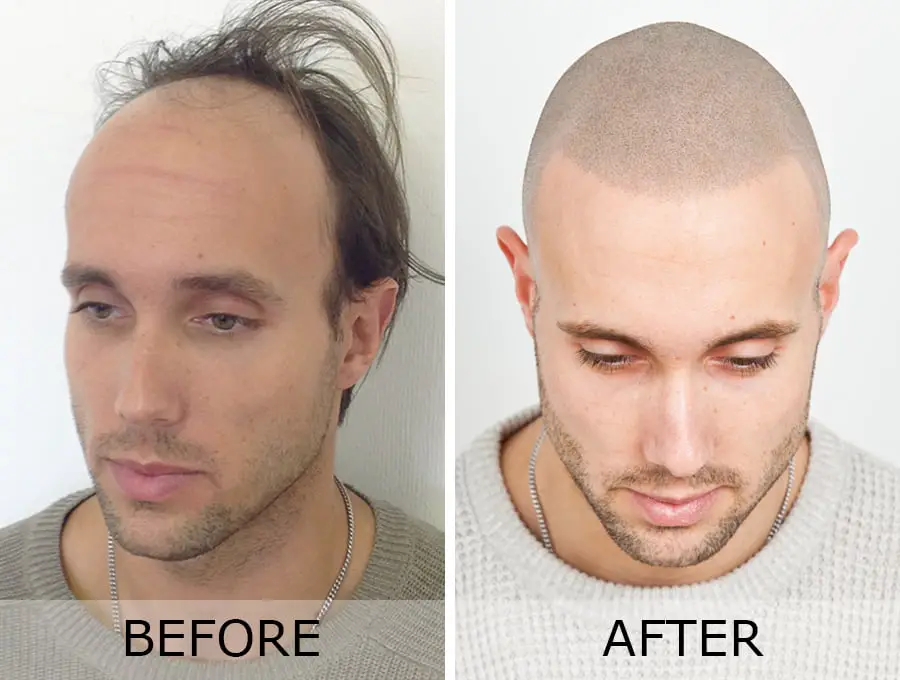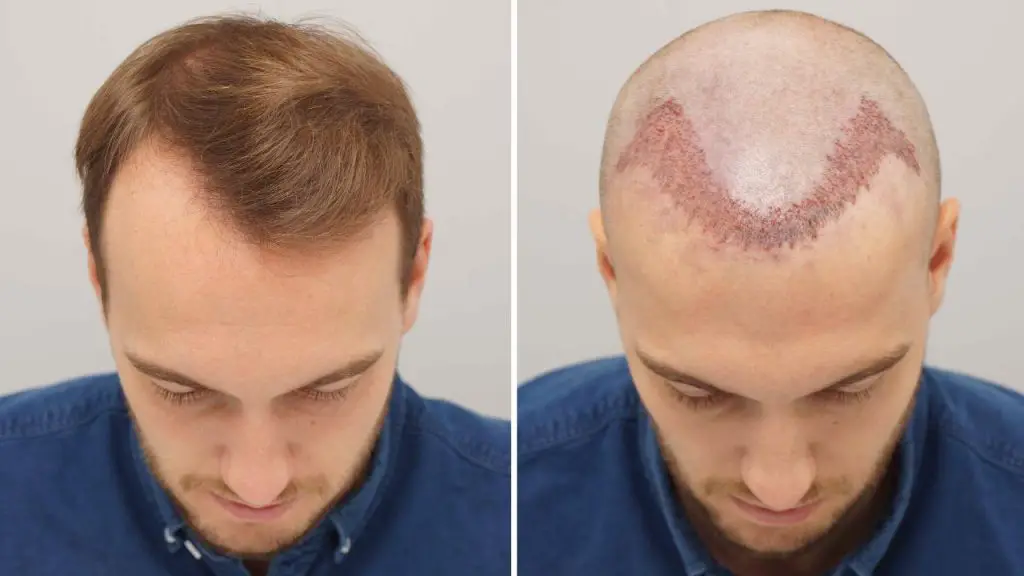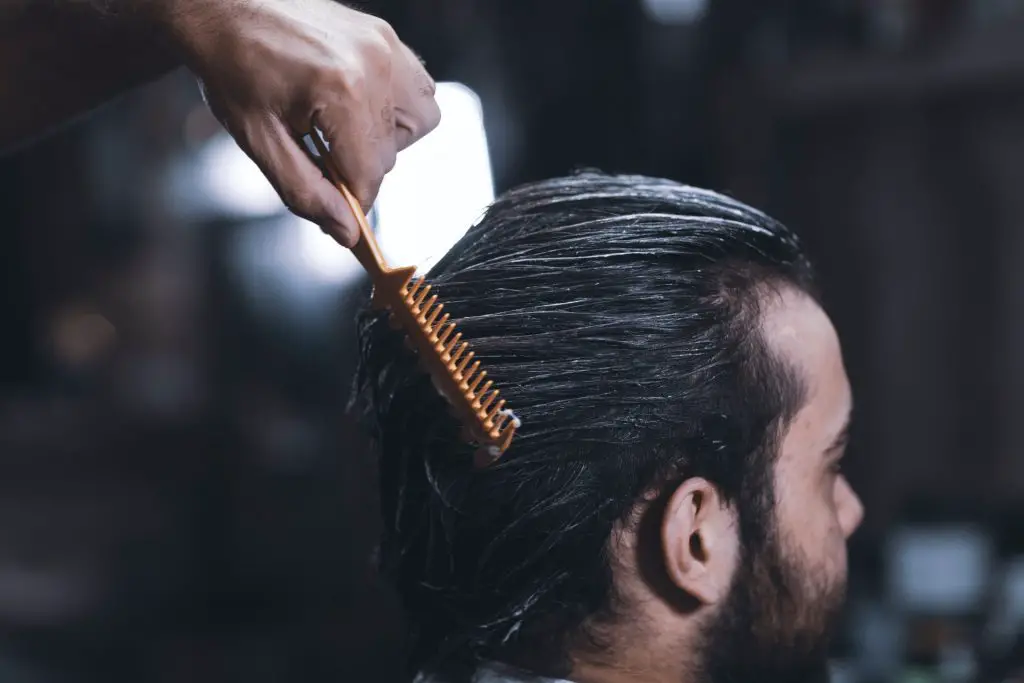Table of Contents
Should I shave my head if I have a receding hairline? Every man probably dreads the time they’d have to ask this question. We have male pattern baldness in our family, so I’m quite nervous about reaching the point where I have to deal with this problem. Many men will just decide to shave it all off since it’s the most practical option. But if you’re still in the denial stage, I will help you deal with a receding hairline and making the decision to get the razor.
What is a receding hairline?

A receding hairline occurs when a person starts balding from the hairline, which looks as if the hair is creeping back. It can also affect the sides of the scalp that will make a person’s forehead appear bigger and wider. This is also called male pattern balding or androgenic alopecia.
Over time, the receding hairline and the bald spot at the back of the head will meet. This will leave the person hairless on top of its head, with a few wispy patches left on the sides. Take note that the manner the hair recedes will vary per person.
What causes male pattern baldness?

Male pattern baldness is a very common problem, with about half of the over 50-year-old population being affected. But as much as it’s prevalent, many men are struggling to cope and adjust to this type of hair loss.
Male pattern baldness is classified using the Norwood-Hamilton scale. It ranks balding from Class I to Class VII, with the latter being the worst. So far, there are no modern treatments known that can reverse male pattern baldness. The higher the class is, the harder it is to stop.
But why is male pattern baldness happening? Experts are still baffled why this occurs, but it’s observed to be passed on within the family. So if your grandfathers, uncles, or father has this problem, there’s a high chance that you’ll also suffer from it later on.
Besides genetics, male pattern baldness is also attributed to the imbalance of the dihydrotestosterone hormone (DHT). This is an androgen or sex hormone responsible for developing male characteristics like a deep voice and hair growth. It also plays a big role in maintaining muscle mass and fertility.
Abnormally high levels of DHT will cause the hair follicles to shrink. This is the reason why your hairline will slowly recede.
Should I shave my head if I have a receding hairline?

The biggest question now is whether you should shave your head or not. The most practical and natural solution is to just shave the remaining hair. Many of my family members with receding hairline said that it’s a liberating experience. They also like not having to buy shampoo too often or worry about styling.
In my opinion, most men look fine when they go bald. However, if you’re thin and lanky, a bald head may not look as good as you’d expected it to be. A friend once told me that if you’re handsome with hair, you’re going to be just as handsome without it.
The good thing here is that you can explore various hairstyles to match your receding hairline. Buzz cuts are a chic option if you still have more hair left. But if your head looks patchy, a clean-cut might suit you well.
Who knows, a bald head might make you look even more masculine. I mean, just look at Dwayne ‘The Rock’ Johnson, Vin Diesel, and Jason Statham. They are rocking bald heads very well.
Alternatives to shaving your receding hairline
If you have a receding hairline, shaving isn’t always the last resort. You can explore other options if you don’t want to go squeaky bald. Here are some that many men try:
1. Micropigmentation

Micropigmentation is becoming more and more popular to men suffering from receding hairlines. Basically, it involves tattooing the hairline into your scalp. While this won’t grow your hair back, it’s an instant solution to cover the bald areas on your head.
If done right, micropigmentation can provide realistic results. Scalp micropigmentation is still a new technique, so finding an expert tattoo artist can be challenging. Also, it’s quite expensive and will require an average of four sessions to finish.
Take note that scalp micropigmentation isn’t like the usual tattoo on the skin. It uses a special ink and microdot method to ensure that it won’t irritate the scalp. The tattoo artist will also use the color that matches your hair and natural skin tone.
After the micropigmentation procedure, it’s important to avoid showering, sweating a lot, swimming, and shaving your head for at least 10 days.
2. Hair transplant

If you want real hair back on your hairline, a hair transplant is the best way to go. To do this, a surgeon will transplant hair from your body into your hairline. Most of the time, surgeons source the hair at the back of the person’s head, but other parts can be considered if the hair is too thin.
There are two types of procedures you can choose for hair transplants: the FUE and FUT.
FUE or Follicular Unit Extraction is done by shaving the back of the head then harvesting each hair follicle from the scalp. After that, these follicles will be grafted into your hairline so hair will grow. This is a very painstaking process and may require several sessions, depending on how much hair you want to grow.
On the other hand, FUT or Follicular Unit Transplantation involves removing a piece of your scalp and tearing it into minuscule grafts. These grafts will be transplanted to your hairline. However, FUT has a longer recovery period since it’s more invasive than FUE.
However, hair transplants aren’t absolute solutions. There’s still a chance that you’ll lose hair. Also, it’s important to take approved medications to ensure that the transplanted hair follicles will be healthy and functional.
3. Hair loss medications

There are several hair loss medications available in the market for those who can’t afford micropigmentation or hair transplants. So far, only two are approved to curb hair loss or delay receding hairline: Propecia and Minoxidil.
Propecia, traditionally known as Finasteride, is an oral pill that can help reduce further hair loss. It’s also a prescription drug for male pattern baldness, so you simply can’t buy it over the counter.
Moreover, Propecia is a 5-Alpha-Reductase inhibitor drug, which also works as a medication for prostatic hyperplasia. Just note that this medicine can have serious side effects if not used properly. It includes breast changes, nipple discharge, impotence, abnormal ejaculation, and trouble having an orgasm.
On the other hand, Minoxidil is a topical medication, more popularly known as Rogaine in the United States and Regaine in the U.K. It’s available in 2% and 5% solutions, depending on the potency you need for your hairline.
It’s very important to use the right dosage to prevent side effects like eczema, burning, abnormal hair growth, and worsening hair loss. So far, Minoxidil can be bought over the counter, though I still recommend consulting a physician first.
4. Hair growth shampoo

Are you scared to try medications right away? If so, you can help reduce hair loss with a hair growth shampoo. But just like any topical solution, this doesn’t guarantee immediate or massive results.
These products help keep your scalp healthy. However, it can’t stop male pattern baldness since no medications or products are proven to halt this condition. Nevertheless, it prevents scalp problems that may worsen balding.
5. Experiment with hairstyles

Lastly, you can try various hairstyles to hide your receding hairline. Aside from buzz cuts and clean shaves, the following are also excellent options:
- Comb over hairstyle. Nah, it’s not the Donald Trump kind of comb-over. It’s more of an Anderson Cooper-suave-comb-over. It uses the receding hairline as the lowest point of the part line. With that, your hair gets a sense of weight despite the hair loss.
- Regulation cut. This takes inspiration from the military, where there’s a defined part with longer scissor cuts. It’s similar to comb-overs but more relaxed.
- Messy look. Do you want to hide your receding hairline? A messy, tousled look will usually do it. You need substantial hair growth here so that you can brush it a bit toward the hairline.
- Short high fade. To prevent accentuating your receding hairline, you can clip the sides and taper it higher than usual. This also makes your receding hairline fade, which makes it less noticeable.
If you’re not sure what suits your face shape, it’s always best to consult your trusty barber.
How to shave a receding hairline properly
If you’ve resigned yourself to the idea of shaving your receding hairline clean, it’s important that you know how to do it right. Here are some steps to help you:
Step 1. Soften your hair first
You can soften up your hair by taking a warm shower before shaving. Also, you should wipe out excess moisture so it’s not dripping wet. If you still have a considerable length, trim it with scissors or a clipper.
Step 2. Use a shaving gel
After that, apply a shaving gel evenly all over your head. This will help soften up the stubble, so the razor will glide smoothly on your scalp.
Step 3. Get the right razor
It’s also important to use a clean shave razor for a smooth result. This will also prevent snagging and razor wounds. In this post, I reviewed 7 of the best clean shave razors for every skin type.
Step 4. Start shaving with light strokes
Start shaving using gentle strokes and work on a small section of your head first. Always shave along the grain on your first pass. Don’t rush shaving because it will only make your scalp bumpy and the result uneven.
Step 5. Rinse and re-shave
Once you’re done with the first pass, give your scalp a quick rinse on the sink. Dry it with a towel, then apply a shaving gel again. This time, you can try going against the grain to cut the remaining hair length. Go gently and rinse the razor once in a while when the shaving gel is already getting thick.
Step 6. Rinse your head and dry
Once done, give your head a final rinse. You can also use shampoo to remove any dirt left on your scalp. Right after drying your bald head, apply an aftershave lotion to prevent irritation. A newly shaved scalp can become irritated easily, so it’s important to keep it moisturized all the time.
Frequently Asked Questions
Q: Will shaving ruin my hairline?
A: Shaving your head clean won’t affect your hairline as long as you do it right. Use a sharp razor and go gently with your scalp. However, if you have male pattern baldness, your hairline will still recede, whether you shave it or not.
Q: Can a receding hairline grow back?
A: Receding hairline due to male pattern baldness can’t be reversed or grown back. Unless you availed of hair transplants, there’s no way your hair will grow back normally. In many cases, men just decide to shave it off instead of trying to hide the baldness.
Q: Is it normal to have a receding hairline at 15?
A: While receding hairline is more common in men over 25 years of age, it can also occur in teenagers. This is possible if your family members have a notorious history of male pattern baldness. Early intervention may help delay the balding in this case.
Q: Does long hair hide a receding hairline?
A: A longer hair can help you hide your receding hairline with the right style. A tousled look is the most stylish option, together with a suave comb-over. However, you should avoid combing wispy hair to desperately cover bald spots.
Final words
Should I shave my head if I have a receding hairline? The answer to this depends on your preference. Many men are rocking bald heads with pride, so it shouldn’t feel like a life sentence. You can also explore various hairstyles to bring back your confidence to your hair.

